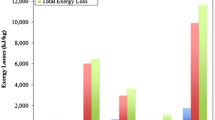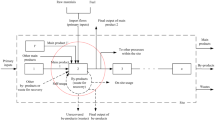Abstract
Maleic anhydride may be obtained from different technological routes, being the selective oxidation of benzene and oxidation of butane the only ones that are currently in operation and, hence, represent competitive alternatives. In this paper, the said technologies are compared with regard to their economics and ecological performances in order to assert which one corresponds to the cleanest technology. The economics of each process was estimated on the basis of their respective cash flows, while the environmental comparison was carried out through the Eco-efficiency Comparison Index method by estimating six different categories of eco-indicators and seven life cycle metrics. To the best of our knowledge, such technologies have not been compared in terms of a joint evaluation of life cycle and eco-efficiency metrics, let alone considering the design of their respective utility plants. Finally, a sensitivity analysis was performed in order to analyze how the heuristic parameters for the utility plants considered in this work affect the estimation of the said indicators. The butane technology was shown to be more sustainable than the benzene process, since it was approximately 72% more profitable and 38% more eco-efficient than the latter.
Graphical abstract














Similar content being viewed by others
Abbreviations
- A :
-
Heat transfer area
- C1:
-
Column 1
- C2:
-
Column 2
- C benzene :
-
Benzene composition
- C butene :
-
n-Butane composition
- C MAN :
-
Maleic anhydride composition
- C oxygen :
-
Oxygen composition
- D i :
-
Inner diameter
- E1:
-
Cooler 1
- E2:
-
Cooler 2
- E3:
-
Cooler 3
- E4:
-
Cooler 4
- E C :
-
CO2 emissions eco-indicator
- E comb :
-
Total thermal energy from combustion consumption
- E E :
-
Energy use eco-indicator
- E F :
-
Fuel consumption eco-indicator
- E ind :
-
Total electricity consumption
- Emcomb :
-
Total CO2 emissions due to thermal energy consumption
- Emfug :
-
Total CO2 emissions due burning off-gases in the flare
- Emind :
-
Total CO2 emissions due to electricity consumption
- E RM :
-
Raw material consumption eco-indicator
- E W :
-
Water consumption eco-indicator
- E WW :
-
Wastewater generation eco-indicator
- f :
-
Temperature difference factor
- F1:
-
Fired heater
- H :
-
Pump head
- H1:
-
Heater 1
- H2:
-
Heater 2
- H3:
-
Heater 3
- K1:
-
Compressor
- L :
-
Vessel length
- ṁ MAN :
-
Maleic anhydride mass flow rate
- ṁ NG :
-
Natural gas mass flow rate
- ṁ RM :
-
Raw material mass flow rate
- P1:
-
Pump 1
- P2:
-
Pump 2
- P3:
-
Pump 3
- P4:
-
Pump 4
- P5:
-
Pump 5
- P6:
-
Pump 6
- p B :
-
Partial pressure of butane
- P c :
-
Compressor power
- p M :
-
Partial pressure of MAN
- Q :
-
Energy requirement
- R1:
-
Tubular reactor
- \(\dot{V}\) :
-
Volumetric flow rate
- V1:
-
Vessel 1
- V2:
-
Vessel 2
- V3:
-
Vessel 3
- \(\dot{\nu}\) bfw :
-
Boiler feed water volumetric flow rate
- \(\dot{\nu}\) cw :
-
Cooling water volumetric flow rate
- \(\dot{\nu}\) hps :
-
High-pressure steam volumetric flow rate
- \(\dot{\nu}\) lps :
-
Low-pressure steam volumetric flow rate
- \(\dot{\nu}\) mps :
-
Medium-pressure steam volumetric flow rate
- x benzene :
-
Benzene molar fraction
- x cumene :
-
Cumene molar fraction
- x DIPB :
-
p-Diisopropyl benzene molar fraction
- α :
-
Cooling water loss factor (process)
- ß :
-
Cooling water loss factor (cooling tower)
- γ :
-
Cooling water loss factor (blowdown)
- δ :
-
Cooling water make-up
- ε :
-
Steam loss factor (condensate losses)
- ζ :
-
Steam loss factor (boiler blowdown)
- η :
-
Steam loss factor (feed water treatment)
- θ :
-
Feed water make-up
- ATP:
-
Aquatic toxicity potential
- bfw:
-
Boiler feed water
- cw:
-
Cooling water
- ECI:
-
Eco-efficiency Comparison Index
- EPA:
-
US Environmental Protection Agency
- GWP:
-
Global warming potential
- hps:
-
High-pressure steam
- HTPI:
-
Human toxicity potential by ingestion
- HTPE:
-
Human toxicity potential by inhalation
- IPCC:
-
Intergovernmental Panel on Climate Change
- LCA:
-
Lice cycle assessment
- lps:
-
Low-pressure steam
- MAN:
-
Maleic anhydride
- MOC:
-
Material of construction
- mps:
-
Medium-pressure steam
- ng:
-
Natural gas
- NPV:
-
Net present value
- NRTL:
-
Non-random two liquid
- PCOP:
-
Photochemical oxidation potential
- PEI:
-
Potential environmental impact
- TTP:
-
Terrestrial toxicity potential
- UNCTAD:
-
United Nations Conference on Trade and Development
- WAR:
-
Waste reduction
References
Access Intelligence LLC (2019) Economic indicators: CECPI february 2019. Chemical engineering. https://www.chemengonline.com/pci. Accessed 10 Mar 2019
Alonso-Fagúndez N, Ojeda M, Mariscal R, Fierro JLG, Granados ML (2017) Gas phase oxidation of furfural to maleic anhydride on V2O5/γ-Al2O3 catalysts: reaction conditions to slow down the deactivation. J Catal 348:265–275
Baerns M (2004) Basic principles in applied catalysis. Springer series in chemical physics 75. Springer, Berlin
Banco Central do Brasil (2018) Interest rates. Banco Central do Brasil. https://www.bcb.gov.br/Pec/Copom/Ingl/taxaSelic-i.asp. Accessed 08 May 2018
Centi G, Cavani F, Trifirò F (2001) Selective oxidation by heterogeneous catalysis, fundamental and applied catalysis. Springer, New York
Chatzidimitriou A, Bond JQ (2015) Oxidation of levulinic acid for the production of maleic anhydride: breathing new life into biochemicals. Green Chem 17:4367–4376
Chen H, Shonnard DR (2004) Systematic framework for environmentally conscious chemical process design: early and detailed design stages. Ind Eng Chem Res 43:535–552
Deloitte (2017) International tax: Brazil highlights 2017. Deloitte. https://www2.deloitte.com/content/dam/Deloitte/cn/Documents/international-business-support/deloitte-cn-ibs-brazil-int-tax-en-2017.pdf. Accessed 08 May 2018
Ebner JR, Keppel RA, Mummey MJ (1999) High productivity process for the production of maleic anhydride, US Pat. 6005121. Huntsman Petrochemical Corporation
EPA – U.S. Environmental Protection Agency (1980) Benzene emissions from maleic anhydride industry—background information for proposed standards. EPA, Research Triangle Park
EPA – U.S Environmental Protection Agency (2008) Project type: industrial boiler efficiency. NSCEP, https://www.epa.gov/nscep. Accessed 08 May 2018
Felthouse TR, Burnett JC, Horrell B, Mummey MJ, Kuo YJ (2001) Maleic anhydride, maleic acid and fumaric acid. In: Kirk–Othmer encyclopedia of chemical technology. Wiley, New York
Fermeglia M, Longo G, Toma L (2009) Computer aided design for sustainable industrial processes: specific tools and applications. AIChE J 55:1065–1078
Frank ME (1975) Recycle process for oxidation of n-butane to maleic anhydride, US Pat. 3904652. Standard Oil Company
Godefroy A, Patience GS, Tzakova T, Garrait D, Dubois JL (2009) Reactor technologies for propane partial oxidation to acrylic acid. Chem Eng Technol 32:373–379
ICIS – Independent Chemical Information System (2013) Price and market trends: US maleic acid contracts dip and buyers seek further decreases. https://www.icis.com/resources/news/2013/04/21/9660668/price-and-market-trends-us-maleic-acid-contracts-dip-and-buyers-seek-further-decreases/. Accessed 08 May 2018
ICIS – Independent Chemical Information System (2018) Indicative chemical prices A-Z. ICIS. https://www.icis.com/chemicals/channel-info-chemicals-a-z/. Accessed 08 May 2018
IPCC – Intergovernmental Panel on Climate Change (2006) Guidelines for national greenhouse gas inventories. IGES, Hayama
Junqueira PG, Mangili PV, Santos RO, Santos LS, Prata DM (2018) Economic and environmental analysis of the cumene production process using computational simulation. Chem Eng Process 130:309–325
Mangili PV, Prata DM (2019) Improvement of the butyl acetate process through heat integration: a sustainability-based assessment. Chem Eng Process 135:93–107
Mangili PV, Dias RF, Santos LS, Prata DM (2018a) Comparison of the CO2 emissions from two maleic anhydride production processes through computational simulation. Latin Am Appl Res. (accepted)
Mangili PV, Souza YPDM, Menezes DQF, Santos LS, Prata DM (2018b) Eco-efficiency evaluation of acetone-methanol separation processes using computational simulation. Chem Eng Process 123:100–110
Matar S, Hacth LF (2000) Chemistry of petrochemical processes, 2nd edn. Gulf Publishing Company, Houston
Mordor Intelligence (2018) Maleic anhydride market - segmented by type, end-user industry, and geography - growth, trends, and forecast (2019–2024). Mordor intelligence. https://www.mordorintelligence.com/industry-reports/global-maleic-anhydride-market-industry. Accessed 11 Mar 2019
Musa OM (2016) Handbook of maleic anhydride based materials: synthesis, properties and applications. Springer, Switzerland
Pereira CP, Prata DM, Santos LS, Monteiro LPC (2018) Development of eco-efficiency comparison index through eco-indicators for industrial applications. Braz J Chem Eng 35:69–89
Peters MS, Timmerhaus KD, West RE (2003) Plant design and economics for chemical engineers, 5th edn. The McGraw-Hill Companies Inc., New York
PwC – PricewaterhouseCoopers (2018) Brazil: corporate—deductions. PwC. http://taxsummaries.pwc.com/ID/Brazil-Corporate-Deductions. Accessed 08 May 2018
Rase HF (2010) Handbook of commercial catalysts: heterogeneous catalysts. CRC Press LLC, Florida
Seider WD, Seader JD, Lewin DR, Widagdo S (2008) Product and process design principles, 3rd edn. Wiley, New Jersey
Sharma RK, Cresswell DL, Newson EJ (1991) Kinetics and fixed-bed reactor modeling of butane oxidation to maleic anhydride. AIChE J 37:39–47
Silla H (2003) Chemical process engineering: design and economics. Marcel Dekker Inc., New York
Sinnott RK (2005) Chemical engineering design, vol. 6. Coulson and Richardson’s chemical engineering series, vol 6. Elsevier Butterwoth-Heinemann, Oxford
Smith R (2005) Chemical process design and integration. Wiley, West Sessex
The Chemical Company (2016) EPCA special edition: critical raw materials and chemical markets. The Chemical Company. https://thechemco.com/epca-special-edition/. Accessed 08 May 2018
Towler G, Sinnott R (2008) Chemical engineering design: principles, practice and economics of plant and process design. Elsevier Butterwoth-Heinemann, Oxford
Trinks W, Mawhinney MH, Shannon RA, Reed RJ, Garvey JR (2004) Industrial furnaces, 6th edn. Wiley, Hoboken
Turton R, Bailie RC, Whiting WB, Shaelwitz JA (2010) Analysis, synthesis and design of chemical processes, 4th edn. Prentice Hall, Upper Saddle River
Tvedt TJ, Holloway RT (1997) Consensus on operating practices for the control of feedwater and boilerwater chemistry in modern industrial boilers (ASME I00367). NACE International. (dúvida se tem cidade)
UNCTAD – United Nations Conference on Trade and Development (2004) A manual for the preparers and users of eco-efficiency indicators. United Nations, New York
Westerink EJ, Westerterp KR (1988) Safe design of cooled tubular reactors for exothermic multiple reactions: multiple-reaction networks. Chem Eng Sci 43:1051–1069
Acknowledgements
This study was financed in part by the Coordenação de Aperfeiçoamento de Pessoal de Nível Superior —Brasil (CAPES)—Finance Code 001.
Author information
Authors and Affiliations
Corresponding author
Additional information
Publisher's Note
Springer Nature remains neutral with regard to jurisdictional claims in published maps and institutional affiliations.
Rights and permissions
About this article
Cite this article
Mangili, P.V., Junqueira, P.G., Santos, L.S. et al. Eco-efficiency and techno-economic analysis for maleic anhydride manufacturing processes. Clean Techn Environ Policy 21, 1073–1090 (2019). https://doi.org/10.1007/s10098-019-01693-1
Received:
Accepted:
Published:
Issue Date:
DOI: https://doi.org/10.1007/s10098-019-01693-1




